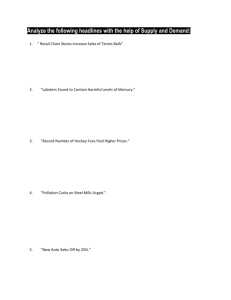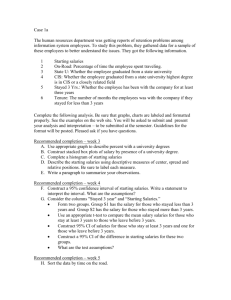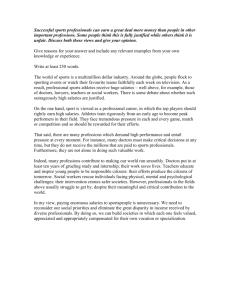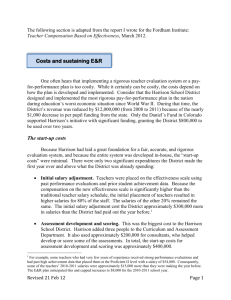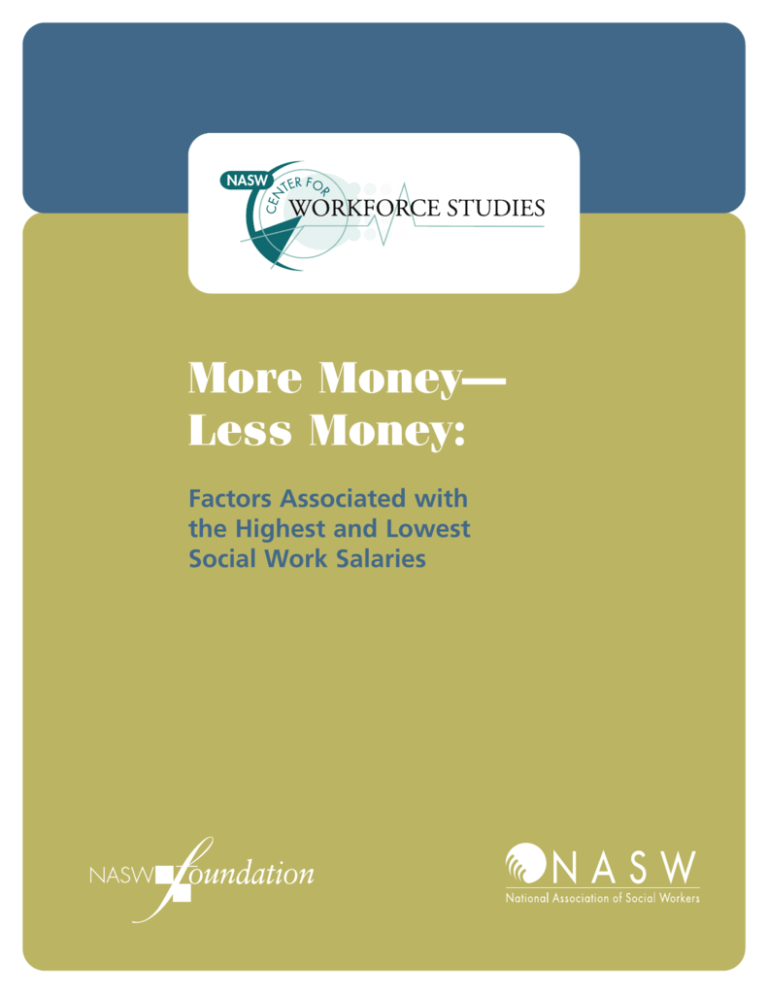
NASW
More Money—
Less Money:
Factors Associated with
the Highest and Lowest
Social Work Salaries
NATIONAL ASSOCIATION OF SOCIAL WORKERS
Elvira Craig de Silva, DSW, ACSW
NASW President
Elizabeth J. Clark, PhD, ACSW, MPH
Executive Director
NASW CENTER FOR WORKFORCE STUDIES
Tracy Whitaker, DSW, ACSW
Director
Melvin Wilson, MBA, LCSW-C
Manager, Workforce Development & Training
Perétte Arringtn, PsyD
Sr. Research Associate
Gwendoline Nkabyo
Sr. Administrative Assistant
©2007 National Association of Social Workers. All Rights Reserved.
Table of Contents
Background ..................................................................................................2
Methodology ................................................................................................3
Salary Overview ............................................................................................4
Summary of Findings ....................................................................................6
Discussion of Findings ..................................................................................7
Conclusion ................................................................................................25
More Money—Less Money: Factors Associated with the Highest and Lowest Social Work Salaries
Background
In 2004, the National Association of Social Workers (NASW) partnered with the
Center for Health Workforce Studies, University at Albany, to conduct a benchmark
national study of 10,000 licensed social workers. The study achieved a response rate
of nearly 50 percent. The information presented in this report is based on that study
and its findings.
As with any profession, there are a number of factors that are commonly associated
with higher earnings. The study found that social work salaries were highly variable.
Table 1 summarizes the variables that had a statistically significant effect on social
work salaries.i
TABLE 1.
SUMMARY OF VARIABLES WITH A STATISTICALLY SIGNIFICANT RELATIONSHIP
WITH ESTIMATED SALARIES OF LICENSED SOCIAL WORKERS WORKING FULL-TIME
IN A SINGLE SOCIAL WORK JOB
Variable
General Nature of the Relation to Salary Level
Gender
Men had higher salaries
Census Division
Pacific region had the highest salaries; South Central had
the lowest salaries
Highest SW Degree
PhDs/DSWs had highest salaries; MSWs had second highest salaries
Rural/Urban Location
Social workers in metropolitan areas had the highest salaries; those
in rural areas had the lowest salaries
Size of Primary Caseload
Social workers without caseloads had the highest salaries; those
with caseloads of 11-15 and 26-50 clients had the lowest salaries
Sector of Employment
Private practice had highest salaries; private not-for-profit
had the lowest salaries
Years of Experience
Each year of experience was associated with about $419 more salary.
More Money—Less Money: Factors Associated with the Highest and Lowest Social Work Salaries
page 2
Methodology
This report compares and contrasts characteristics of social workers at the lowest
end of the pay continuum (those earning less than $30,000 per year) with those
social workers at the highest end of the spectrum (those earning more than
$80,000 per year).
This report is based on data from social workers who reported earnings from one
full-time social work position (n=2632). Eighty-six percent of the full-time employees
(n=2261) earned between $30,000 and $79,999 per year. Seven percent of the
respondents (n=182) earned less than $30,000 per year; and seven percent (n=189)
earned more than $80,000 per year (Figure 1).
FIGURE 1.
DISTRIBUTION OF FULL-TIME SOCIAL WORK EMPLOYEES’ SALARIES
More than $80,000 per year
Less than $30,000 per year
25%
19%
14%
12%
10%
6%
5%
4%
2%
less than
$24,000/yr
$25,000 - $30,000 $29,999/yr $34,999/yr
$35,000 $39,999/yr
$40,000 $49,999/yr
$50,000 $59,999/yr
$60,000 $69,999/yr
$70,000 $79,999/yr
3%
$80,000 - $100,000 +/yr
$99,999/yr
More Money—Less Money: Factors Associated with the Highest and Lowest Social Work Salaries
page 3
Salary Overview
Sixty-nine percent of social workers earning less than $30,000 per year earned between
$25,000 and $29,999 per year and 31 percent earned less than $24,999. On the other end
of the continuum, 62 percent of social workers in the higher salary level earned between
$80,000 and $99,999 per year and 38 percent earned more than $100,000 (Figure 2).
FIGURE 2.
DISTRIBUTION OF LOWER AND HIGHER SALARIES
Less than $30,000 per year
69%
More than $80,000 per year
62%
38%
31%
<$24,999
$25k - $29,999
$80-$99,999
$100,000+
REGIONAL ANALYSIS
The regions of the country that had the highest percentages of lower-earning social
workers were the South Atlantic (25%); the East North Central (23%); and the West
North and the West South Central (14% each). The regions of the country with the
highest percentages of higher-earning social workers were the South Atlantic (26%);
the Middle Atlantic (23%); the Pacific (16%); and the East North Central region (10%).
Interestingly, two regions, the East North Central region and the South Atlantic region,
had high percentages of both categories of salaries (Figure 3).
More Money—Less Money: Factors Associated with the Highest and Lowest Social Work Salaries
page 4
FIGURE 3.
SALARY DISTRIBUTION BY REGION
More than $80,000 per year
Less than $30,000 per year
25% 26%
23%
14%
23%
16%
14%
10%
West North
Central
East North
Central
West South
Central
South Atlantic
Middle Atlantic
Pacific
SALARIES BY STATE
Nine percent of the respondents who earned less than $30,000 per year lived in
West Virginia; eight percent lived in Texas; South Carolina and Wisconsin each had six
percent of these respondents; and five percent lived in Ohio. In comparison, 15 percent
of those reporting salaries greater than $80,000 per year lived in New York; 13 percent
lived in California; eight percent lived in Maryland; seven percent resided in New
Jersey; and 6 percent lived in Michigan (Figure 4).
FIGURE 4.
SALARY DISTRIBUTION BY STATE
Less than $30,000 per year
More than $80,000 per year
15%
13%
5%
South
Carolina
6%
Wisconsin
8%
9%
Texas
West
Virginia
6%
5%
Ohio
California
8%
7%
Michigan Maryland New Jersey New York
More Money—Less Money: Factors Associated with the Highest and Lowest Social Work Salaries
page 5
Summary of Findings
❶
Social workers who earn higher salaries are more likely to be older, male, to hold an
MSW as their highest degree, and to be licensed in more than one state.
❷
Social workers who are recent graduates, who have less experience, and those who
have fewer years of employment are more likely to earn lower salaries.
❸
Social workers who are employed in the private, for-profit sector, in a private solo
practice, and specialize in mental health are more likely to earn higher salaries.
❹
Social workers who earn lower salaries are more likely to work in challenging agency
environments and to serve more vulnerable clients.
❺
Social workers who earn lower salaries are less satisfied with their compensation
packages and more likely to plan to leave the profession.
More Money—Less Money: Factors Associated with the Highest and Lowest Social Work Salaries
page 6
Discussion of Findings
❶ Social workers who earn higher salaries are more likely to be older,
male, to hold an MSW as their highest degree, and to be licensed
in more than one state.
AGE
The distribution of the respondents’ ages varied greatly according to their salary levels.
Only 11 percent of the higher-earning social workers were 44 years old or younger,
compared with 54 percent of those who earned less. On the other hand, 89 percent
of the higher earners were 45 and older, compared with less than half (45%) of the
lower earners. (Figure 5).
FIGURE 5.
AGE
More than $80,000 per year
Less than $30,000 per year
89%
54%
45%
11%
44 years and younger
45 years +
More Money—Less Money: Factors Associated with the Highest and Lowest Social Work Salaries
page 7
GENDER
As is true in most professions, the survey revealed a gender gap in salaries for
licensed social workers in 2004. The gender composition also shifted dramatically
between the highest and lowest salary levels. Eighty-nine percent of the lower earners
were women, compared with 57 percent of the higher-earning women. In contrast,
only 11 percent of the lower earners were men, compared with 43 percent of the
higher-earning men (Figure 6).
FIGURE 6.
SALARY DISTRIBUTION BY GENDER
Less than $30,000 per year
More than $80,000 per year
89%
57%
43%
11%
Female
Male
HIGHEST SOCIAL WORK DEGREE
Of those respondents who earned less than $30,000 per year, more than half had a
BSW as their highest social work degree, compared with only two percent of the
higher earners who held a BSW as their highest degree. In contrast, 88 percent of the
higher earners had an MSW as their highest social work degree and 42 percent of the
lower-earners had an MSW as their highest social work degree. Among the higher
earners, 10 percent held a doctorate degree (Figure 7).
More Money—Less Money: Factors Associated with the Highest and Lowest Social Work Salaries
page 8
FIGURE 7.
HIGHEST SOCIAL WORK DEGREE
Less than $30,000 per year
More than $80,000 per year
88%
55%
42%
10%
2%
DSW/PhD
MSW
BSW
MULTIPLE STATE LICENSES
Twenty percent of the higher earners held a social work license in more than one
state, compared with only eight percent of the lower earners (Figure 8).
FIGURE 8.
SALARY LEVELS BY MULTIPLE STATE LICENSE-HOLDERS
Less than $30,000 per year
More than $80,000 per year
20%
8%
Holds SW License in More Than One State
More Money—Less Money: Factors Associated with the Highest and Lowest Social Work Salaries
page 9
❷ Recent Social Work graduates, who have less experience, and have
fewer years of employment are more likely to earn lower salaries.
YEAR OF MSW GRADUATION
More recent MSW graduates were likely to earn less, with 67 percent of those earning
less than $30,000 per year having graduated since 1990. In contrast, 80 percent of the
higher earners graduated prior to 1989 (Figure 9).
FIGURE 9.
SALARY DISTRIBUTION BY YEAR OF MSW GRADUATION
More than $80,000 per year
Less than $30,000 per year
80%
67%
33%
20%
1950-1989
1990-2000
More Money—Less Money: Factors Associated with the Highest and Lowest Social Work Salaries
page 10
YEARS OF PRACTICE EXPERIENCE
Social workers earning the lowest salaries were more likely to be in their first
10 years of practice. Social workers earning the highest salaries were more likely
to have worked more than 10 years (Figure 10).
FIGURE 10.
YEARS OF PRACTICE
Less than $30,000 per year
75%
More than $80,000 per year
67%
17%
20%
16%
5%
0 - 10 years
11- 29 years
30+ years
More Money—Less Money: Factors Associated with the Highest and Lowest Social Work Salaries
page 11
YEARS WITH EMPLOYER
Nearly half of the higher-earning social workers have worked for their employers for
more than 16 years. A majority of the lower-earners have worked for their employers
for fewer than five years (Figure 11).
FIGURE 11.
YEARS WITH PRIMARY EMPLOYER
Less than $30,000 per year
More than $80,000 per year
73%
49%
38%
20%
13%
7%
< 1-5 years
6-15 years
16+ years
More Money—Less Money: Factors Associated with the Highest and Lowest Social Work Salaries
page 12
❸ Social workers who are employed in the private, for-profit sector, in a
private solo practice, and who specialize in mental health are more likely
to earn higher salaries.
EMPLOYMENT SECTOR
Salary levels were associated with employment sector. Forty-seven percent of those
earning more than $80,000 per year were employed in the private, for-profit sector,
compared with 24 percent of those who earned less than $30,000 per year. These
percentages were nearly reversed for the private, non-profit sector, with 39 percent
of lower-earning social workers working in this sector compared with 26 percent
of higher-earning social workers. Those earning lower salaries also had higher
percentages in the state and local government sectors (Figure 12).
FIGURE 12.
EMPLOYMENT SECTOR
Less than $30,000 per year
More than $80,000 per year
47%
39%
26%
24%
25%
14%
2%
Private, forprofit
Private,
nonprofit
11% 9%
2%
3%
Federal Gov
State Gov
Local Gov
Military
More Money—Less Money: Factors Associated with the Highest and Lowest Social Work Salaries
page 13
EMPLOYMENT SETTING
The top five employment settings for each salary level were analyzed. Nearly
40 percent of higher-earning social workers worked in a private, solo practice,
whereas one-quarter of lower-earning social workers worked in a social service
agency. Interestingly, there were nearly equal percentages of high and low
earners in the other settings (Figure 13).
FIGURE 13.
EMPLOYMENT SETTING
More than $80,000 per year
Less than $30,000 per year
37%
25%
10%
Private Solo
Practice
9%
Social Service
Agency
7% 7%
7%
Behavioral Health Case Management
Agency
Clinic
7%
7%
School
7%
Hospital/Medical
Center
More Money—Less Money: Factors Associated with the Highest and Lowest Social Work Salaries
page 14
PRACTICE AREA
The five most frequently listed practice areas were analyzed for each salary level.
Fifty-five percent of those earning the higher salaries identified mental health as
their practice area, followed by health (6%). School social work, adolescents, and
aging each were listed by five percent of the top earners. Twenty-four percent of
those earning lower salaries identified mental health or child welfare/family as their
practice areas, followed by aging, (14%), adolescents (10%), and developmental
disabilities (8%) (Figure 14).
FIGURE 14.
PRACTICE AREA
Less than $30,000 per year
More than $80,000 per year
55%
24%
24%
14%
10%
5%
Adolescents
8%
5%
Aging
Child
Welfare/Family
Developmental
Disabilities
6%
Mental
Health
Health
5%
School Social
Work
More Money—Less Money: Factors Associated with the Highest and Lowest Social Work Salaries
page 15
❹ Social workers who earn lower salaries are more likely to work in
challenging agency environments and to serve more vulnerable clients.
AGENCY VACANCIES
Social workers with lower salaries were more likely to work in settings where
vacancies were common and difficult to fill, and where their employer recruited
non-social workers to fill social work positions. Social workers with higher salaries
were more likely to work in environments where their employer recruited non-social
workers and where social work jobs were outsourced (Figure 15).
FIGURE 15.
AGENCY VACANCIES
Less than $30,000 per year
More than $80,000 per year
33%
29%
21%
20%
14%
13%
17%
8%
Vacancies are
Common
Vacancies Difficult
to Fill
Employer Recruits
Non- SW for SW Jobs
SW Jobs are
Outsourced
More Money—Less Money: Factors Associated with the Highest and Lowest Social Work Salaries
page 16
SAFETY
Safety was much more of a concern for social workers in the lower salary ranges.
Fifty-three percent of social workers earning less than $30,000 per year reported
facing personal safety issues on the job, compared with less than one-third of those
who earned more than $80,000 per ear.
ADEQUACY OF EMPLOYER RESPONSE TO SAFETY ISSUES
Although social workers with higher salaries were less likely to face personal safety
issues on their jobs, they were more likely to be dissatisfied with their employers’
responses to safety issues. Of those who identified safety concerns (28%), more than
a one-fourth did not think their employers appropriately addressed their concerns.
Only 20 percent of the social workers earning lower salaries expressed dissatisfaction
with their employers’ handling of safety concerns (Figure 16).
FIGURE 16.
SAFETY CONCERNS
Less than $30,000 per year
More than $80,000 per year
53%
28%
27%
20%
Face Safety Concerns
Dissatisfied with Employer Response
More Money—Less Money: Factors Associated with the Highest and Lowest Social Work Salaries
page 17
CLIENTS’ GENDER AND AGE
The client characteristics of each salary cohort were also analyzed. Sixteen percent
of those earning less than $30,000 per year had caseloads that were more than 75
percent female, compared with seven percent of those earning more than $80,000
per year. Lower-earning social workers also had the highest percentages of clients
under age 21 and over the age of 55. Higher earning social workers had greater
percentages of adult clients between the ages of 22 to 54 (Figure 17).
FIGURE 17.
CLIENT CASELOAD DISTRIBUTION
More than $80,000 per year
Less than $30,000 per year
48%
33%
16%
15%
7%
more than
75% female
21%
14%
5%
more than 51%
under 12 years
9%
7%
more than 51%
between 13-21 years
more than 51%
between 22-54 years
more than 51%
over 55 years
More Money—Less Money: Factors Associated with the Highest and Lowest Social Work Salaries
page 18
SOURCES OF CLIENTS’ HEALTH INSURANCE
Social workers who had lower salaries had higher percentages of clients who had
publicly-funded health insurance than did higher-earning social workers. Sixty-four
percent of the lower salary cohort’s clients were Medicaid recipients, 13 percent were
Medicare recipients, and five percent had clients who did not have health insurance.
Higher-earning social workers were more likely to have clients with private insurance
(50%) or who were private pay (14%) (Figure 18).
FIGURE 18.
CLIENT HEALTH INSURANCE
64%
Medicaid
25%
13%
Medicare
7%
9%
Private Insurance
Private Pay
50%
2%
14%
Not Insured
5%
2%
Don’t Know
6%
3%
Less than $30,000 per year
More than $80,000 per year
More Money—Less Money: Factors Associated with the Highest and Lowest Social Work Salaries
page 19
CLIENTS’ HEALTH CONDITIONS
Social workers in the higher salary cohort reported greater percentages of “many”
clients with psychosocial stressors (72%) and affective conditions (41%) than did
their lower-earning counterparts. In contrast, social workers in the lower salary
cohort reported higher percentages of “many” clients with mental illness (38%),
developmental and physical disabilities (20%, 18%), substance abuse disorders (25%),
acute and chronic medical conditions (17%, 21%), and co-occurring disorders (36%)
(Figure 19).
FIGURE 19.
CLIENT HEALTH CONDITIONS
More than $80,000 per year
Less than $30,000 per year
72%
53%
41%
38% 37%
22%
Mental
Illness
20%
9%
25% 22%
18%
5%
Affective Developmental Physical
Conditions
Disabilities Disabilities
Substance
Abuse
Disorders
36% 34%
17%
7%
Acute
Medical
Conditions
21%
11%
Chronic
Co-Occurring Psychosocial
Medical
Disorders
Stressors
Conditions
“Many” Clients Reporting Condition
More Money—Less Money: Factors Associated with the Highest and Lowest Social Work Salaries
page 20
INTEREST IN FURTHER TRAINING
There were also some differences in areas of interest for further training. A higher
percentage of those earning lower salaries were more interested in training related
to rural areas (23%), substance abuse (25%), and trauma/disaster services (25%) than
their higher-earning counterparts. A higher percentage of social workers earning more
than $80,000 per year were more interested in training related to best practices (25%)
and clinical practice (46%) than those earning less (Figure 20).
FIGURE 20.
AREAS OF INTEREST FOR FURTHER TRAINING
Less than $30,000 per year
Trauma/Disaster
25%
Substance Abuse
25%
Rural Services
23%
Clinical Practice
28%
Best Practices
18%
More than $80,000 per year
22%
13%
3%
46%
25%
More Money—Less Money: Factors Associated with the Highest and Lowest Social Work Salaries
page 21
❺ Social workers who earn lower salaries are less satisfied with their
compensation packages and more likely to plan to leave the profession.
ADEQUACY OF WAGES AND BENEFITS
Seventy-one percent of social workers earning less than $30,000 per year described the
adequacy of their wages as limited or very limited, compared to 29 percent who
described their wages as adequate or very adequate. Conversely, 94 percent of the
higher earners described their salaries as adequate or very adequate, compared with
seven percent who described their wages as limited or very limited.
Social workers earning less than $30,000 per year were more satisfied with their benefits
than with their wages. Fifty-three percent described their benefits as adequate or very
adequate, compared with 48 percent who described their benefits as very limited or
limited. Social workers earning more than $80,000 annually were less satisfied with their
benefits than with their wages, with nearly 30 percent describing their benefits as very
limited or limited (Figure 21).
FIGURE 21.
ADEQUACY OF WAGES AND BENEFITS
Less than $30,000 per year
More than $80,000 per year
94%
73%
71%
53%
48%
20%
26%
7%
Very Limited or
Limited Salaries
Adequate or Very
Adequate Salaries
Very Limited or
Limited Benefits
Adequate or Very
Adequate Benefits
More Money—Less Money: Factors Associated with the Highest and Lowest Social Work Salaries
page 22
BENEFITS
There were some differences in the benefits available to social workers at the two salary
levels. Although both groups reported insurance (health, dental, and life) and the
availability of flexible hours at comparable rates, higher-earners were more likely to list
pensions and tuition reimbursement as part of their benefit packages (Figure 22).
FIGURE 22.
BENEFIT PACKAGES
Less than $30,000 per year
Flexible Hours
Tuition Reimbursement
39%
15%
More than $80,000 per year
43%
30%
Pension
45%
Life Insurance
51%
Dental Insurance
51%
Health Insurance
51%
58%
52%
55%
65%
More Money—Less Money: Factors Associated with the Highest and Lowest Social Work Salaries
page 23
CAREER PLANS
When asked about their career plans for the next two years, the majority of social
workers in both salary levels planned to remain in their current positions (63% and
83%). However, those in the lower salary ranges were more likely to plan to pursue an
additional social work degree (18%) or to seek a new opportunity in social work (35%)
than their higher-earning counterparts. A marked difference occurred with the plan to
leave social work, with 10 percent of the lower-earning cohort choosing that option,
compared to just two percent of the higher-earning cohort (Figure 23).
FIGURE 23.
CAREER PLANS
Less than $30,000 per year
83%
More than $80,000 per year
63%
33%
18%
12%
Remain in Current
Position
Pursue Additional SW
Degree
10%
2%
1%
Seek New SW
Opportunity
Leave SW
More Money—Less Money: Factors Associated with the Highest and Lowest Social Work Salaries
page 24
Conclusion
This report highlights the role of salary in retaining professional workers, particularly
newer workers. Of particular concern is the relationship between low salaries and
agencies that are likely to provide services to the most vulnerable clients—
underscoring a long-held belief that social workers’ salaries are closely linked to the
societal value placed on their clients. Competitive and fair salaries are the first step to
assuring that a competent social work workforce is going to be available to meet the
needs of agencies and their clients in the coming decades.
i Whitaker, T., Weismiller, T., & Clark, E. (2006). Assuring the sufficiency of a frontline workforce: Executive summary.
Washington, DC: National Association of Social Workers.
More Money—Less Money: Factors Associated with the Highest and Lowest Social Work Salaries
page 25

